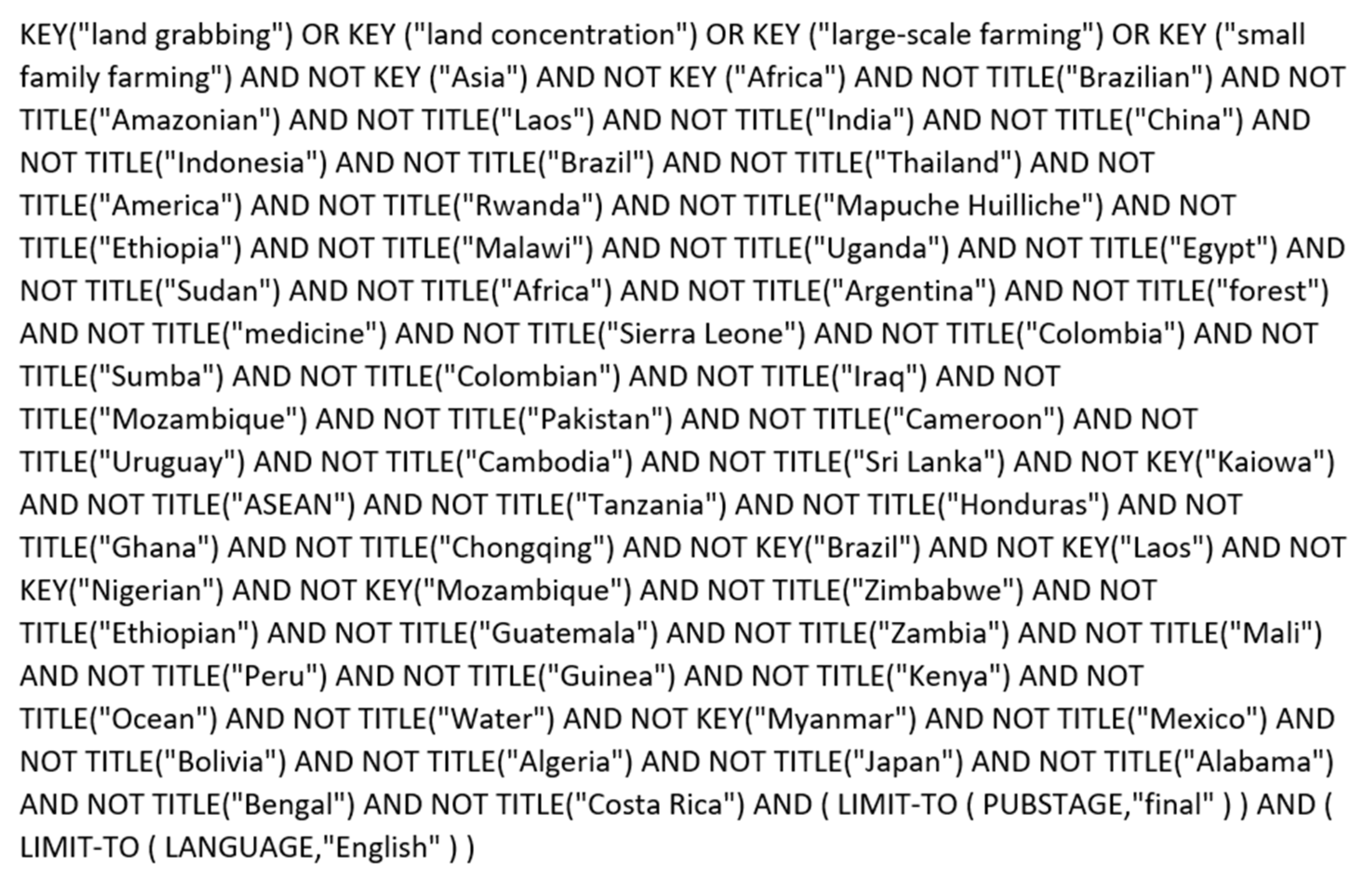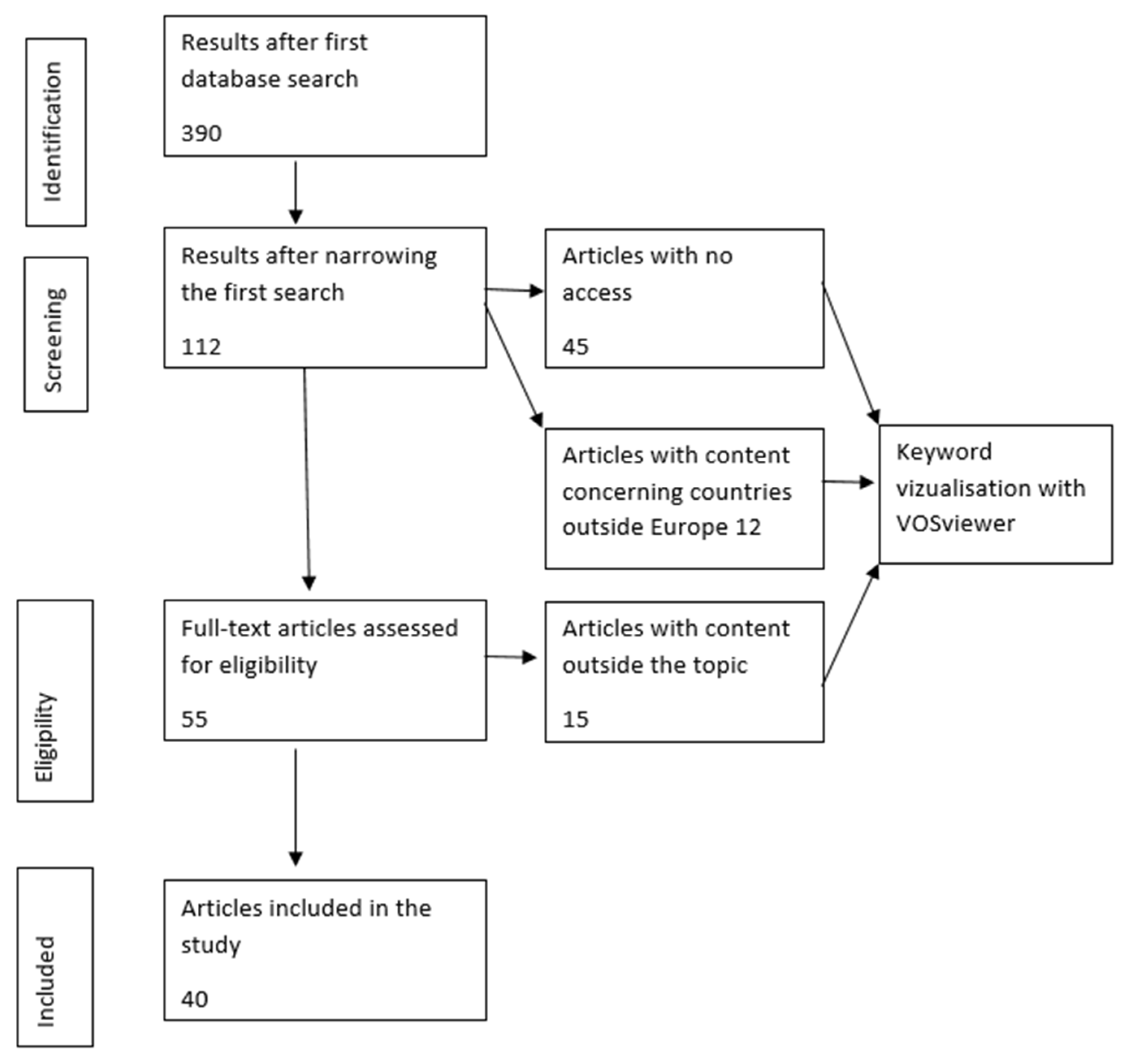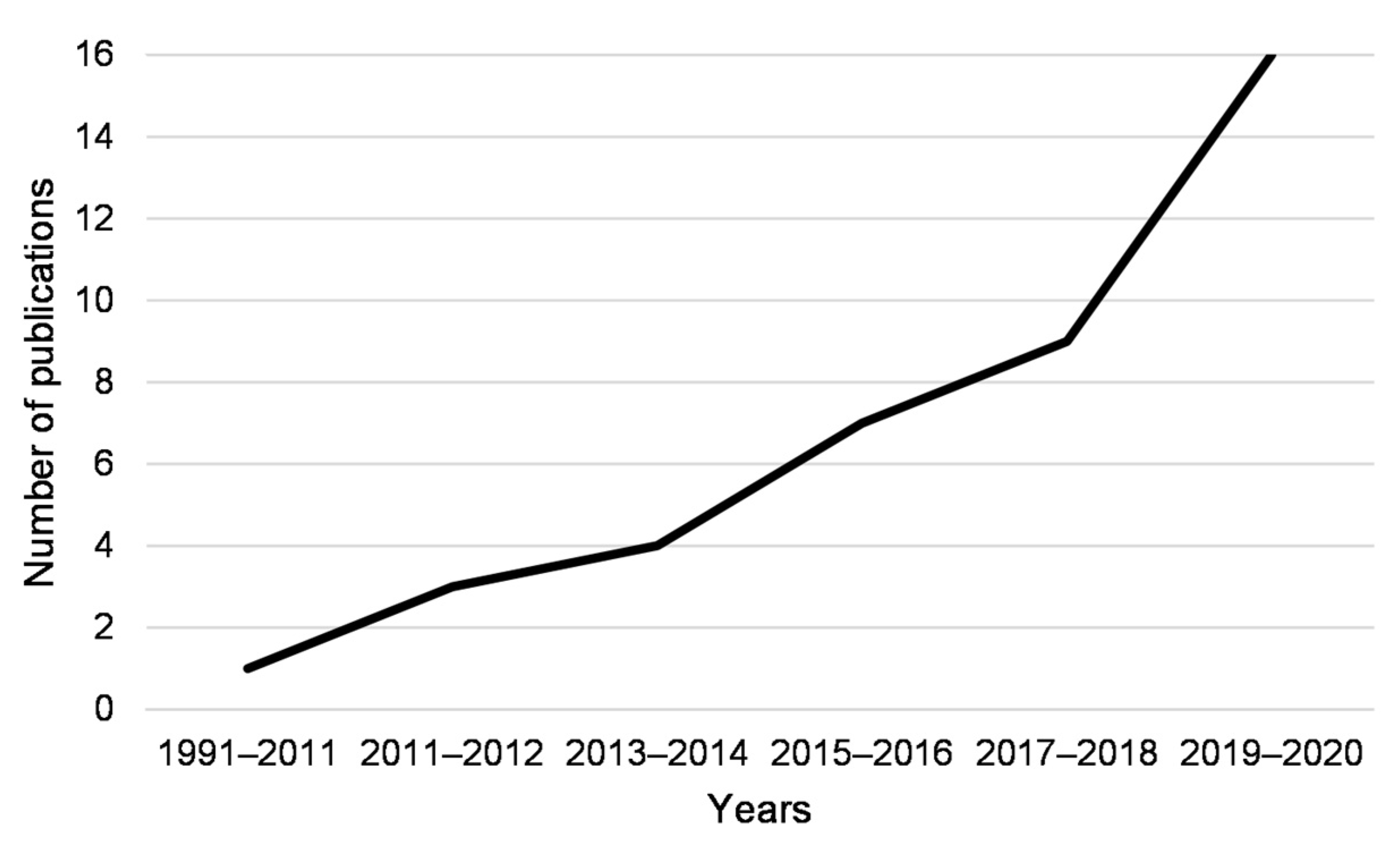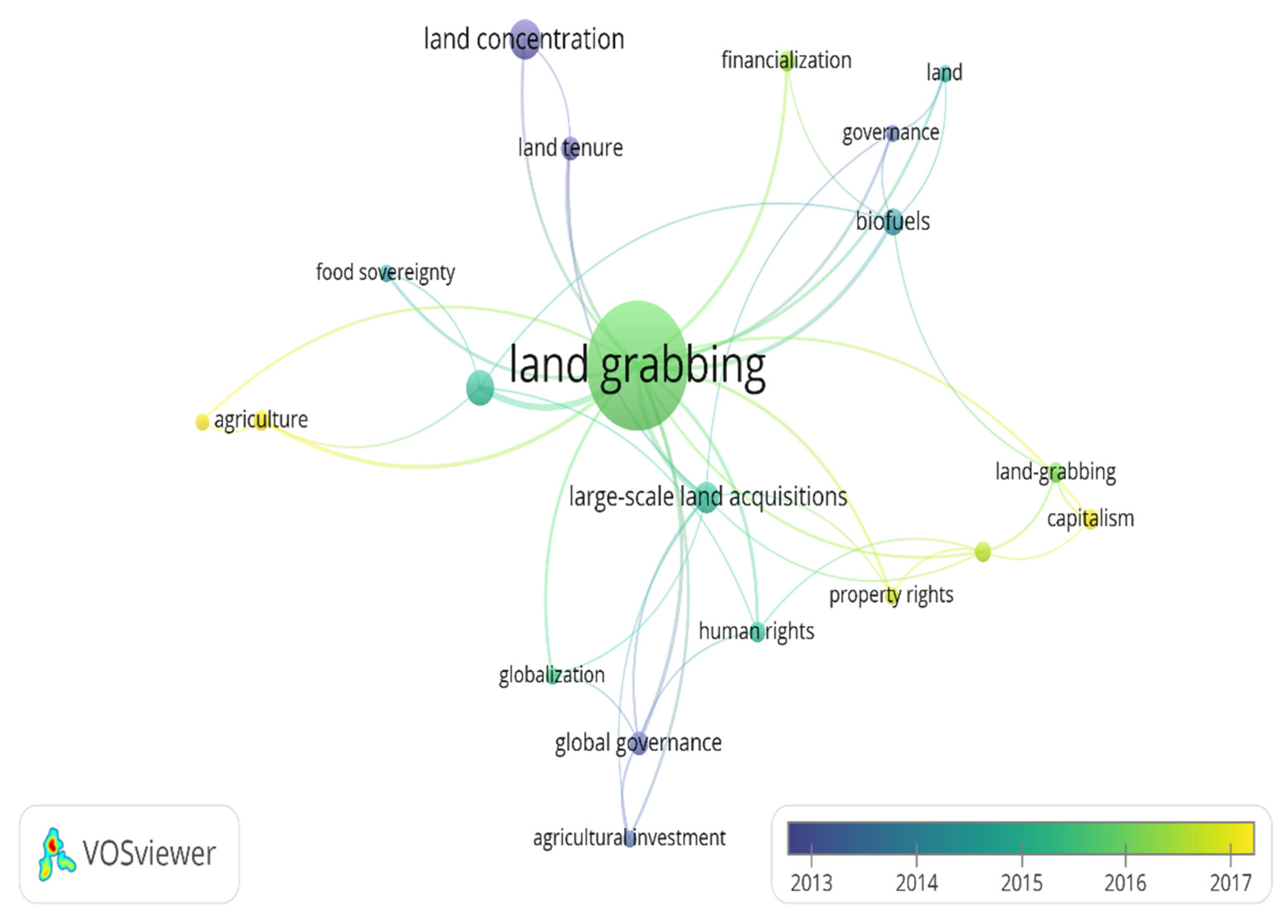Europe’s Large-Scale Land Acquisitions and Bibliometric Analysis
Abstract
1. Introduction
2. Materials and Methods
3. Results
3.1. Europe’s Large Scale Land-Acquisitions
- Making food systems more sustainable;
- Creating income generation opportunities in rural areas;
- Implementing resilient and highly productive agricultural practices;
- Delivering inclusive rural services and contributing to territorial development;
- Promoting food systems that are more resilient to climate change;
- Preserving biodiversity;
- Strengthening sustainable integration between urban and rural areas.
3.2. Bibliometric Analysis
4. Discussion
5. Conclusions
Author Contributions
Funding
Institutional Review Board Statement
Informed Consent Statement
Data Availability Statement
Conflicts of Interest
References
- Benedek, Z.; Fertő, I.; Galamba Marreiros, C.; Aguiar, P.M.D.; Pocol, C.B.; Čechura, L.; Põder, A.; Pääso, P.; Bakucs, Z. Farm diversification as a potential success factor for small-scale farmers constrained by COVID-related lockdown. Contributions from a survey conducted in four European countries during the first wave of COVID-19. PLoS ONE 2021, 16, 5. [Google Scholar] [CrossRef] [PubMed]
- Nolte, K.; Sipangule, K.; Wendt, N. Agricultural households in times of crisis. The COVID-19 pandemic, livelihoods and land-use decisions. J. Land Use Sci. 2022, 17, 134–160. [Google Scholar] [CrossRef]
- European Commission. The European Green Deal; European Commission: Brussels, Belgium, 2019. [Google Scholar]
- Regulation (EU) 2018/841 of the European Parliament and of the Council. 2018. Available online: https://eur-lex.europa.eu/legal-content/EN/TXT/PDF/?uri=CELEX:32018R0842 (accessed on 20 April 2022).
- Van Der Ploeg, J.D.; Franco, J.C.; Borras, S.M. Land concentration and land grabbing in Europe: A preliminary analysis. Can. J. Dev. Stud. 2015, 36, 147–162. [Google Scholar] [CrossRef]
- Petrescu-Mag, R.M.; Petrescu, D.C.; Petrescu-Mag, I.V. Whereto land fragmentation–land grabbing in Romania? The place of negotiation in reaching win–win community-based solutions. Land Use Policy 2017, 64, 174–185. [Google Scholar] [CrossRef]
- Schilling, J.; Saulich, C.; Engwicht, N. Introduction: A local to global perspective on resource governance and conflict. Confl. Secur. Dev. 2018, 18, 433–461. [Google Scholar] [CrossRef]
- Franco, J.C.; Borras, S.M. Grey areas in green grabbing: Subtle and indirect interconnections between climate change politics and land grabs and their implications for research. Land Use Policy 2019, 84, 192–199. [Google Scholar] [CrossRef]
- De Maria, M. Understanding land in the context of large-scale land acquisitions: A brief history of land in economics. Land 2019, 8, 15. [Google Scholar] [CrossRef]
- Santangelo, G.D. The impact of FDI in land in agriculture in developing countries on host country food security. J. World Bus. 2018, 53, 75–84. [Google Scholar] [CrossRef]
- Petrescu, D.C.; Hartel, T.; Petrescu-Mag, R.M. Global land grab: Toward a country typology for future land negotiations. Land Use Policy 2020, 99, 104960. [Google Scholar] [CrossRef]
- Han, J.; Jiang, M.; Zhang, X.; Lu, X. Knowledge Mapping Analysis of Transnational Agricultural Land Investment Research. Land 2021, 10, 1374. [Google Scholar] [CrossRef]
- Palsova, L.; Bandlerova, A.; Machnicova, Z. Land Concentration and Land Grabbing Processes-Evidence from Slovakia. Land 2021, 10, 873. [Google Scholar] [CrossRef]
- Kovách, I.; Megyesi, B.; Bai, A.; Balogh, P. Sustainability and Agricultural Regeneration in Hungarian Agriculture. Sustainability 2022, 14, 969. [Google Scholar] [CrossRef]
- Oberlack, C.; Giger, M.; Anseeuw, W.; Adelle, C. Why do large-scale agricultural investments induce different socio economic, food security, and environmental impacts? Evidence from Kenya, Madagascar, and Mozambique. Ecol. Soc. 2021, 26, 18. [Google Scholar] [CrossRef]
- Chahongnao, S. Customary Tenure and Large-Scale Land Acquisitions in the Global South: Issues and Redressal Approaches in Governance Policy. Acad. Lett. 2021, 4074. [Google Scholar] [CrossRef]
- Gaupp-Berghausen, M.; Schuh, B.; Münch, A.; Badouix, M. The Future of the European Farming Model. In Socio-Economic and Territorial Implications of the Decline in the Number of Farms and Farmers in the EU; Policy Department for Structural and Cohesion Policies, Directorate-General for Internal Policies: Brussels, Belgium, 2022. [Google Scholar]
- Toma, I.; Redman, M.; Czekaj, M.; Tyran, E. Small-scale farming and food security–Policy perspectives from Central and Eastern Europe. Glob. Food Sec. 2021, 29, 100504. [Google Scholar] [CrossRef]
- Marquard, E.; Bartke, S.; Gifreu i Font, J.; Humer, A.; Jonkman, A.; Jürgenson, E.; Bovet, J. Land Consumption and Land Take: Enhancing Conceptual Clarity for Evaluating Spatial Governance in the EU Context. Sustainability 2020, 12, 8269. [Google Scholar] [CrossRef]
- Bruinsma, J. World Agriculture: Towards 2015/2030. An FAO Perspective; Routledge: London, UK, 2003. [Google Scholar]
- Transforming Food Systems with Farmers: A Pathway for the EU; World Economic Forum: Geneva, Switzerland, 2022.
- United Nations. The Sustainable Development Goals Report; United Nations: New York, NY, USA, 2019.
- FAO; IFAD. United Nations Decade of Family Farming 2019–2028. In Global Action Plan; FAO and IFAD: Rome, Italy, 2019. [Google Scholar]
- Borghesi, S.; Giovannetti, G.; Iannucci, G.; Russu, P. The Dynamics of Foreign Direct Investments in Land and Pollution Accumulation. Environ. Resour. Econ. 2019, 72, 135–154. [Google Scholar] [CrossRef]
- Šljukić, S.; Šljukić, M. Sociological aspects of the transformation of agrarian structure of Serbia in 1990–2018. RUDN J. Sociol. 2019, 19, 235–243. [Google Scholar] [CrossRef]
- Mechiche-Alami, A.; Piccardi, C.; Nicholas, K.A.; Seaquist, J.W. Transnational land acquisitions beyond the food and financial crises. Environ. Res. Lett. 2019, 14, 084021. [Google Scholar] [CrossRef]
- Ali, D.A.; Deininger, K. Does Title Increase Large Farm Productivity? Institutional Determinants of Large Land-Based Investments’ Performance in Zambia; World Bank: Washington, DC, USA, 2021. [Google Scholar]
- Beckers, V.; Beckers, J.; Vanmaercke, M.; Van Hecke, E.; Van Rompaey, A.; Dendoncker, N. Modelling Farm Growth and Its Impact on Agricultural Land Use: A Country Scale Application of an Agent-Based Model. Land 2018, 7, 109. [Google Scholar] [CrossRef]
- Plogmann, J.; Mußhoff, O.; Odening, M.; Ritter, M. Farm Growth and Land Concentration; Humboldt-Universität zu Berlin: Berlin, Germany, 2020. [Google Scholar]
- Jürgenson, E.; Rasva, M. The changing structure and concentration of agricultural land holdings in Estonia and possible threat for rural areas. Land 2020, 9, 41. [Google Scholar] [CrossRef]
- Schnepf, R. EU Agricultural Domestic Support: Overview and Comparison with the United States; Congressional Research Service: Washington, DC, USA, 2021.
- Bunkus, R.; Theesfeld, I. Land grabbing in Europe? Socio-cultural externalities of large-scale land acquisitions in East Germany. Land 2018, 7, 98. [Google Scholar] [CrossRef]
- Grant, E.; Das, O. Land grabbing, sustainable development and human rights. Transnatl. Environ. Law 2015, 4, 289–317. [Google Scholar] [CrossRef]
- Borras, S.M., Jr.; Mills, E.N.; Seufert, P.; Backes, S.; Fyfe, D.; Herre, R.; Michéle, L. Transnational land investment web: Land grabs, TNCs, and the challenge of global governance. Globalizations 2020, 17, 608–628. [Google Scholar] [CrossRef]
- Rasva, M.; Jürgenson, E. Changes of agricultural producers in Estonia according to the size of land use. Agron. Res. 2020, 18, 516–528. [Google Scholar]
- The Road to Transformative Agrifood Systems in Europe and Central Asia–Regional Actions to Implement the FAO Strategic Framework 2022-31. 2022. Available online: https://www.fao.org/3/ni178en/ni178en.pdf (accessed on 20 April 2022).
- Ren, C.; Liu, S.; Van Grinsven, H.; Reis, S.; Jin, S.; Liu, H.; Gu, B. The impact of farm size on agricultural sustainability. J. Clean. Prod. 2019, 220, 357–367. [Google Scholar] [CrossRef]
- Constantin, C.; Luminița, C.; Vasile, A.J. Land grabbing: A review of extent and possible consequences in Romania. Land Use Policy 2017, 62, 143–150. [Google Scholar] [CrossRef]
- Falkinger, J.; Grossmann, V. Oligarchic land ownership, entrepreneurship, and economic development. J. Dev. Econ. 2013, 101, 206–215. [Google Scholar] [CrossRef]
- Wuepper, D.; Wimmer, S.; Sauer, J. Is small family farming more environmentally sustainable? Evidence from a spatial regression discontinuity design in Germany. Land Use Policy 2020, 90, 104360. [Google Scholar] [CrossRef]
- Stacherzak, A.; Hełdak, M.; Hájek, L.; Przybyła, K. State interventionism in agricultural land turnover in Poland. Sustainability 2019, 11, 1534. [Google Scholar] [CrossRef]
- Rea, K. The Complexities of Evaluating Land Use Concentration Regarding Closely Related Companies; Estonian University of Life Sciences: Tartu, Estonia, 2018. [Google Scholar]
- Visser, O.; Mamonova, N.; Spoor, M. Oligarchs, megafarms and land reserves: Understanding land grabbing in Russia. J. Peasant Stud. 2012, 39, 899–931. [Google Scholar] [CrossRef]
- Lowder, S.K.; Sánchez, M.V.; Bertini, R. Which farms feed the world and has farmland become more concentrated? World Dev. 2021, 142, 105455. [Google Scholar] [CrossRef]
- Giller, K.E.; Delaune, T.; Silva, J.V.; Descheemaeker, K.; van de Ven, G.; Schut, A.G.; van Ittersum, M.K. The future of farming: Who will produce our food? Food Secur. 2021, 13, 1073–1099. [Google Scholar] [CrossRef]
- Burja, V.; Tamas-Szora, A.; Dobra, I.B. Land concentration, land grabbing and sustainable development of agriculture in Romania. Sustainability 2020, 12, 2137. [Google Scholar] [CrossRef]
- Johnson, H. Legitimacy and accountability in the global governance of large-scale agricultural land investments. J. Sustain. Financ. Investig. 2016, 6, 67–83. [Google Scholar] [CrossRef]
- Zoomers, A.; van Noorloos, F.; Otsuki, K.; Steel, G.; van Westen, G. The Rush for Land in an Urbanizing World: From Land Grabbing Toward Developing Safe, Resilient, and Sustainable Cities and Landscapes. World Dev. 2017, 92, 242–252. [Google Scholar] [CrossRef]
- Torrez, F. La Via Campesina: Peasant-led agrarian reform and food sovereignty. Development 2011, 54, 49–54. [Google Scholar] [CrossRef]
- Tzouvala, N. A false promise? Regulating land-grabbing and the post-colonial state. Leiden J. Int. Law 2019, 32, 235–253. [Google Scholar] [CrossRef]
- Dell’Angelo, J.; D’Odorico, P.; Rulli, M.C.; Marchand, P. The Tragedy of the Grabbed Commons: Coercion and Dispossession in the Global Land Rush. World Dev. 2017, 92, 1–12. [Google Scholar] [CrossRef]
- Haller, T. The different meanings of land in the age of neoliberalism: Theoretical reflections on commons and resilience grabbing from a social anthropological perspective. Land 2019, 8, 104. [Google Scholar] [CrossRef]
- Carroccio, A.; Crescimanno, M.; Galati, A.; Tulone, A. The land grabbing in the international scenario: The role of the EU in land grabbing. Agric. Food Econ. 2016, 4, 12. [Google Scholar] [CrossRef]
- Özsu, U. Grabbing land legally: A Marxist analysis. Leiden J. Int. Law 2019, 32, 215–233. [Google Scholar] [CrossRef]
- Gonda, N. Land grabbing and the making of an authoritarian populist regime in Hungary. J. Peasant Stud 2019, 46, 606–625. [Google Scholar] [CrossRef]
- Metta, M.; Wetzels, H.; Campos, R.M.A. CAP Reform Post 2020: Lost in Ambition? Agricultural and Rural Convention–ARC2020: Paris, France, 2020. [Google Scholar]
- Bondoc, I. European Regulation in the Veterinary Sanitary and Food Safety Area, a Component of the European Policies on the Safety of Food Products and the Protection of Consumer Interests: A 2007 Retrospective. Part One: The Role of European Institutions in Laying. In Universul Juridic, Supliment; Revista Universul Juridic: Bucharest, Romania, 2016; Available online: http://revista.universuljuridic.ro/supliment/european-regulation-veterinary-sanitary-food-safety-area-component-european-policies-safety-food-products-protection-consumer-interests-2007-retrospective/ (accessed on 2 April 2022).
- Juhasz, J. Large-scale and small-scale farming in Hungarian agriculture: Present situation and future prospects. Eur. Rev. Agric. Econ. 1991, 18, 399–415. [Google Scholar] [CrossRef]
- Mamonova, N. Resistance or adaptation? Ukrainian peasants’ responses to large-scale land acquisitions. J. Peasant Stud. 2015, 42, 607–634. [Google Scholar] [CrossRef]
- FAO. Trade and Food Security: Conceptualizing the Linkages Expert Consultation; FAO: Rome, Italy, 2002. [Google Scholar]
- Tscharntke, T.; Clough, Y.; Wanger, T.C.; Jackson, L.; Motzke, I.; Perfecto, I.; Vandermeer, J.; Whitbread, A. Global food security, biodiversity conservation and the future of agricultural intensification. Biol. Conserv. 2012, 151, 53–59. [Google Scholar] [CrossRef]
- Aday, S.; Aday, M.S. Impact of COVID-19 on the food supply chain. Food Qual. Saf. 2020, 4, 167–180. [Google Scholar] [CrossRef]
- Gruszczynski, L. The COVID-19 Pandemic and International Trade: Temporary Turbulence or Paradigm Shift? Eur. J. Risk Regul. 2020, 11, 337–342. [Google Scholar] [CrossRef]
- Lay, L.; Anseeuw, W.; Eckert, S.; Flachsbart, I. Taking stock of the global land rush: Few development benefits, many human and environmental risks. In Analytical Report III; Centre for Development and Environment (CDE), University of Bern: Bern, Switzerland, 2021. [Google Scholar]
- Chiarelli, D.D.; D’Odorico, P.; Müller, M.F.; Mueller, N.D.; Davis, K.F.; Dell’Angelo, J.; Rulli, M.C. Competition for water induced by transnational land acquisitions for agriculture. Nat. Commun. 2022, 13, 505. [Google Scholar] [CrossRef]
- Mirumachi, N.; Duda, A.; Gregulska, J.; Smetek, J. The Human Right to Drinking Water: Impact of Large-Scale Agriculture and Industry; Policy Department for External Relations Directorate, General for External Policies of the Union: Brussels, Belgium, 2021. [Google Scholar]
- Renzaho, A.M.N.; Kamara, J.K.; Toole, M. Biofuel production and its impact on food security in low and middle income countries: Implications for the post-2015 sustainable development goals. Renew. Sustain. Energy Rev. 2017, 78, 503–516. [Google Scholar] [CrossRef]
- Margulis, M.E.; McKeon, N.; Borras, S.M., Jr. Land Grabbing and Global Governance: Critical Perspectives. Globalizations 2013, 10, 1–23. [Google Scholar] [CrossRef]
- Borras, S.M., Jr.; Franco, J.C.; Wang, C. The Challenge of Global Governance of Land Grabbing: Changing International Agricultural Context and Competing Political Views and Strategies. Globalizations 2013, 10, 161–179. [Google Scholar] [CrossRef]
- FAO. Voluntary Guidelines on the Responsible Governance of Tenure of Land, Fisheries and Forests in the Context of National Food Security; FAO: Rome, Italy, 2012. [Google Scholar]
- UNDP. UNDP Proposals for Managing Land Reform in Zimbabwe; Independent Evaluation Office United Nations: New York, NY, USA, 2013. [Google Scholar]
- Somkosi, P. The Interaction between the Land Reform Programme and the Land Market in South Africa; University of Fort Hare: Alice, South Africa, 2021. [Google Scholar]
- Gilbert, J. Land Rights as Human Rights: The Case for a Specific Right to Land. SSRN Electron. J. 2013, 18, 15. [Google Scholar] [CrossRef][Green Version]
- REVIVE. Our Land. In A Vision for Land Reform in Scotland and How We Get There; 2021; Available online: https://revive.scot/publication/our-land-a-vision-for-land-reform-in-scotland-and-how-we-get-there/ (accessed on 20 April 2022).




| Keyword | Occurrences |
|---|---|
| Land grabbing | 85 |
| Land concentration | 12 |
| Food security | 10 |
| Large-scale land acquisitions | 8 |
| Biofuels | 6 |
| Global governance | 5 |
| Land tenure | 5 |
| International law | 4 |
| Human rights | 4 |
| Agriculture | 4 |
| Capitalism | 4 |
| Financialization | 4 |
| Land-grabbing | 4 |
| Agricultural investment | 3 |
| Governance | 3 |
| Globalization | 3 |
| Land | 3 |
| Property rights | 3 |
| Food sovereignty | 3 |
| Land fragmentation | 3 |
Publisher’s Note: MDPI stays neutral with regard to jurisdictional claims in published maps and institutional affiliations. |
© 2022 by the authors. Licensee MDPI, Basel, Switzerland. This article is an open access article distributed under the terms and conditions of the Creative Commons Attribution (CC BY) license (https://creativecommons.org/licenses/by/4.0/).
Share and Cite
Rasva, M.; Jürgenson, E. Europe’s Large-Scale Land Acquisitions and Bibliometric Analysis. Agriculture 2022, 12, 850. https://doi.org/10.3390/agriculture12060850
Rasva M, Jürgenson E. Europe’s Large-Scale Land Acquisitions and Bibliometric Analysis. Agriculture. 2022; 12(6):850. https://doi.org/10.3390/agriculture12060850
Chicago/Turabian StyleRasva, Marii, and Evelin Jürgenson. 2022. "Europe’s Large-Scale Land Acquisitions and Bibliometric Analysis" Agriculture 12, no. 6: 850. https://doi.org/10.3390/agriculture12060850
APA StyleRasva, M., & Jürgenson, E. (2022). Europe’s Large-Scale Land Acquisitions and Bibliometric Analysis. Agriculture, 12(6), 850. https://doi.org/10.3390/agriculture12060850






